DOI:10.32604/cmc.2022.026306

| Computers, Materials & Continua DOI:10.32604/cmc.2022.026306 |  |
| Article |
Fuzzy Aggregator Based Energy Aware RPL Routing for IoT Enabled Forest Environment
1Department of Data Science and Business Systems, School of Computing, SRM Institute of Science and Technology, Chennai, 603203, Tamilnadu, India
2Department of Networking and Communications, School of Computing, SRM Institute of Science and Technology, Chennai, 603203, Tamilnadu, India
3ITMO University, St. Petersburg, Russia
4Senac Faculty of Ceará, Fortaleza, CE, Brazil
5Instituto de Telecomunicações, Covilhã, 6201-001, Portugal
*Corresponding Author: Suresh Sankaranarayanan. Email: sureshs3@srmist.edu.in
Received: 21 December 2021; Accepted: 22 February 2022
Abstract: Forested areas are extremely vulnerable to disasters leading to environmental destruction. Forest Fire is one among them which requires immediate attention. There are lot of works done by authors where Wireless Sensors and IoT have been used for forest fire monitoring. So, towards monitoring the forest fire and managing the energy efficiently in IoT, Energy Efficient Routing Protocol for Low power lossy networks (E-RPL) was developed. There were challenges about the scalability of the network resulting in a large end-to-end delay and less packet delivery which led to the development of Aggregator-based Energy Efficient RPL with Data Compression (CAA-ERPL). Though CAA-ERPL proved effective in terms of reduced packet delivery, less energy consumption, and increased packet delivery ratio for varying number of nodes, there is still challenge in the selection of aggregator which is based purely on probability percentage of nodes. There has been research work where fuzzy logic been employed for Mobile Ad-hoc Routing, RPL routing and cluster head selection in Wireless Sensor. There has been no work where fuzzy logic is employed for aggregator selection in Energy Efficient RPL. So accordingly, we here have proposed Fuzzy Based Aggregator selection in Energy-efficient RPL for region thereby forming DODAG for communicating to Fog/Edge. We here have developed fuzzy inference rules for selecting the aggregator based on strength which takes residual power, Node degree, and Expected Transmission Count (ETX) as input metrics. The Fuzzy Aggregator Energy Efficient RPL (FA-ERPL) based on fuzzy inference rules were analysed against E-RPL in terms of scalability (First and Half Node die), Energy Consumption, and aggregator node energy deviation. From the analysis, it was found that FA-ERPL performed better than E-RPL. These were simulated using MATLAB and results.
Keywords: Fuzzy logic; aggregator; IoT; RPL; routing; wireless sensor network
Forest Fire has an enormous impact on natural losses that cause serious damage to the flora and fauna. Most of the fires are happening in seasonal periods. The common reason for the fire is due to land dryness, soil erosion, deviations in temperature, less moisture, etc. There are lots of initiatives taken by forest management to monitor all these activities remotely and provide appropriate control action [1]. Internet of Things could provide a solution with the escalation of support for forest fires, making tactical decisions for firefighting, and identify areas for post-fire restoration and rehabilitation activities [2]. Applications that are specific to environment monitoring need development by the way of better-enhanced routing in Low Power Lossy Networks (LLNs). Through continued development, the Internet of Things has broadened its application range; it has a wider range of applications in real-time location identification [3], data fusion [4], robot path tracking [5], event identification [6], etc. Routing over Low Power Lossy Network (ROLL) Working Group in the Internet Engineering Task Force (IETF) has proposed a routing protocol for low power lossy networks (RPL). RPL [7] is built using an objective function of the nodes to form a destination-oriented directed acyclic graph (DODAG). The objective function used in routing protocol for low power lossy network (RPL) rank calculation usually depends on hop count. The limitation of the traditional RPL is that it takes ETX metric only to choose the parent node for the DODAG formation.
In terms of Forest fire monitoring where the energy of nodes is scarce, Energy-efficient RPL (E-RPL) [8] has been developed. E-RPL takes energy along with ETX as the objective function. The RANK of the node determines the strength of the parent node. Due to the scalability of E-RPL, the network experiences a large end-to-end delay and the delivery of packets is limited. Furthermore, sensor nodes consume more energy with increasing transmission range. To overcome the drawbacks in E-RPL, compressed data aggregation and energy-based RPL routing (CAA-ERPL) [9] was proposed. The aggregation scheme has been proposed for balancing the load, minimizing the delay, improving the scalability of the network, and reducing the power consumption. In addition to aggregation, the data compression is also included at the aggregator for reducing the number of packets to be transmitted to Border Router and in turn, optimize the power consumption. Though CAA-ERPL resulted in better performance with aggregator selection and data compression, the selection of aggregator is based on the probability percentage of nodes only. Fuzzy logic comes in handy which provides flexibility for reasoning.
Fuzzy logic been used for routing in Mobile Ad-hoc Network and RPL. Also, fuzzy mechanism been used in selection of cluster head in Wireless Sensor based on multiple input metrics. There has been no work where fuzzy logic used for selection of aggregator in Energy Efficient RPL. So, we here have proposed Fuzzy Based Aggregator selection in Energy-efficient RPL for IoT-Fog based forest Fire Monitoring where 6lowpan sensor nodes are deployed. In this work, the Fuzzy mechanism is used in the selection of aggregators in the region. This is based on input variables which are ETX, Node degree, and Energy of nodes towards forming fuzzy sets for mapping to output variable which is the aggregator strength. The major contributions of work are as follows:
■ Aggregator selection based on Fuzzy mechanism
■ Formulation of Fuzzy Inference Rules for Aggregator Selection
■ Formulation of Aggregation Ratio for data aggregation
■ Validation of FA-ERPL against E-RPL in terms of Network Life, Energy consumption, and Energy deviation of aggregators
The rest of the paper is organized as follows. Section 2 discussed related works relevant to the proposed research work. Section 3 discusses the proposed Fuzzy Aggregator based RPL (FA-RPL). Section 4 discusses the simulation setup. Section 5 gives the Results and Analysis of FA-ERPL vs. Energy Efficient RPL (E-RPL). Section 6 gives the conclusion and future work.
There are lot of works going on in IoT-based applications to save energy with the help of aggregation of data [10], efficient clustering and routing of packets [11,12], data compression [13], reducing the communication delay [14], etc. Most of the existing protocols and techniques are targeted towards efficient routing for the improvement in the network lifetime. An energy-saving routing procedure is required in forest management to improve network performance. A wide range of techniques related to IoT-based routing in an energy-constrained environment are discussed below. Agarwal et al. proposed a two stage probabilistic fuzzy based routing protocol for the mobile ad-hoc network applications [15]. In the first stage the protocol identifies the possibility of all the paths between source and the destination. Out of all the possible paths, the best path is selected via fuzzy controller by implementing the fuzzy rules on the path parameters. The challenge here is the route selection is done for the static nodes only. The protocol is simulated and analyzed by using NS-2.
Cluster-based routing is undertaken by LLN [16]. The entire network is divided into multiple clusters of unequal size, and the cluster head is chosen according to the residual energy of each node. Cluster Head is responsible for the data aggregation. Since there is no aggregation of data packets in Contiki RPL, the protocol is implemented in Contiki and compared with RPL on the basis of scalability and lifetime. The limitations of the work are pertaining to the delay created by the control messages.
In [17], the authors used a composite metric to evaluate the best path for all the nodes in the network. Parent nodes are selected via energy and link quality of the node. All nodes do participate in the DODAG and finally, the data reaches the border router. The performance of the protocol is compared with RPL in terms of packet delivery ratio. The main challenge in the work is that there is no data aggregation imposed on the node which makes all the nodes in the network participate in the DODAG which increases the communication delay. Kamgueu et al. have considered composite metrics for the RANK function calculation towards DODAG formation in RPL [18]. The authors have used delay and ETX metrics to specify the QoS output by employing a fuzzy mechanism. The energy of the node is also considered to find the best parent for the DODAG. The work is suitable for both network energy distribution and packet reception rates. The authors here have not considered the latency and jitter for routing.
In [19], Bhandari et al. proposed a priority-based aggregation and on-demand-based channel access. Data packets are efficiently aggregated by using the preemptive queuing model where high priority and low priority queues are sorted before being forwarded to the gateway. Several agglomeration schemes are proposed for sensor data collection. The challenge in this work is that the routing in the channel is not discussed. Verma et al. proposed a framework for an energy-optimized network environment [20]. The protocol called sleep-based scheduling consists of two stages. By using a meta-heuristic approach called Tunicate Swarm optimization algorithm, intermediate heads are selected. Parameters such as node energy, time delay, network average energy, node proximity are taken for the fitness function to choose the appropriate region heads. Second stage deals with the sleep scheduling implementation of the closely located nodes. The main advantage of the sleep mode is to abate the total number of transmissions. The challenge in this paper is that physical obstacles, high temperatures are not considered during real-time implementation.
Shakya et al. established a modification in the objective function to develop a path for smart metering applications [21]. ETX and lifetime are considered as metrics to calculate the rank of the node for DODAG formation. The authors here have considered only ETX and lifetime only which is a challenge. The other parameters like Energy, link quality is not considered for DODAG formation. Mehra et al. [22] proposed a methodology called balanced cost Cluster Head selection algorithm that considered residual energy, proximity to sink, and density of the node in its vicinity as inputs to a fuzzy inference system. The probability is assigned to each sensor node as per the fuzzy membership rule for choosing the best candidate for the coordinator role that ensures load balancing. The sink node receives more information and the frequency with which information is forwarded increases. The residual energy per round is higher as compared to the LEACH protocol. For proving the performance of the protocol, the authors compared it with basic LEACH protocol only. Tom et al. [23] have proposed an aggregator-based RPL for IoT–Fog-based power distribution system. The aggregator is selected based on ETX as an objective function among smart meters for communication by forming DODAG. The challenge in this work is that CPU utilization, number of parent changes, and QoS metric are not taken into consideration. Additionally, only ETX was taken for aggregator selection in forming the DODAG, and other metrics were not considered. Energy Efficient RPL for IoT-Fog based Forest fire monitoring takes energy along with ETX as an objective function for DODAG formation and communicate to Parent Node. The challenge in E-RPL is that the network experienced large end-to-end delays and less packet delivery. Also, the 6lowpan nodes here consume more energy with increasing transmission ranges. CAA-ERPL is an improvement over E-RPL where aggregator selected randomly for forest region. The aggregator is selected by taking energy and ETX as objective functions towards forming DODOAG for communication to Parent Node. In addition, data compression is done at the aggregator for reducing the number of packets transmitted to the Border router resulting in optimized power consumption. This work resulted in load balancing, minimized delay, improvisation in network scalability, and reduction in energy consumption. The challenge in this work is that aggregator selection is based on probabilistic values only. The selection of aggregator has not taken any composite metric in framing decision rules for deciding the aggregator strength for efficient routing.
So based on the literature reviewed, it is clear that there has been some considerable work done in terms of routing and aggregation in RPL for extending the network lifetime, increased packet delivery ratio, and improved reliability. So, towards routing in a resource-constrained environment like forest, energy Efficient RPL was proposed. The energy Efficient RPL has been improvised by introducing the concept of aggregator and data compression in a resource-constrained environment. The aggregator selection was based on energy and ETX towards forming DODAG for routing. The challenge in the above-mentioned work is that the aggregator used for energy-efficient routing was purely based on the probabilistic percentage of nodes in the region towards forming DODAG. The selection of aggregator cannot be based purely on the probabilistic percentage of nodes and usage of fuzzy logic can be effective. Fuzzy helps in deciding on strength of the aggregator which is based on fuzzy inference rules. There has been work where fuzzy mechanism has been used for routing in Mobile Ad-hoc Network and RPL. Also, fuzzy mechanism been used in selection of cluster head in Wireless Sensor based on multiple input metrics. So based on the above-mentioned drawbacks in RPL routing in resource constrained environment and usage of fuzzy mechanisms in RPL routing and Wireless Sensor for cluster head selection, we here have proposed Fuzzy based Aggregator selection in Energy Efficient routing in RPL which is novel . The details are discussed in the forthcoming section.
3 Fuzzy Based Aggregator Selection for IoT–Fog-Enabled Forest Region
IoT-Fog-enabled Forest fire network require timely delivery of information of the highest quality and minimal latency towards the analysis of real-time data captured from environmental sensors for action. These IoT-Fog-based systems are deployed with 6lowpan sensors which are resource-constrained in terms of energy. In applications like forest fire, energy-efficient routing is very important for real-time analysis and action. So, towards this, RPL routing protocol devised by ROLL working group for 6lowpan network been modified as Energy Efficient RPL (E-RPL) by taking energy and ETX as metrics. The challenge in E-RPL is that the network experiences large end-to-end delay and less packet delivery. Also, the 6lowpan nodes here consume more energy with increased transmission range. So, towards obviating the above-mentioned drawbacks, Aggregator-based Energy Efficient RPL with data compression (CAA-ERPL) has been developed which is an improvement over E-RPL. The aggregator in this algorithm is selected by taking Energy and ETX as metrics for forming DODAG with 6lowpan sensor nodes. The aggregator is responsible for compressing the data received from sensor nodes and forming DODAG with other aggregators for routing data to Fog/Edge for analysis. This work resulted in load balancing, minimized delay, improvisation in network scalability, and reduction in energy consumption.
In all the above-mentioned work, energy and ETX have been used as metrics for aggregator selection. The selection of aggregators was based purely on probabilistic values of sensor nodes. There has been no usage of composite metrics in framing the rule-based system in the selection of aggregators based on its strength. This would result in more optimized routing. Literature shows that Fuzzy based mechanism has been used in RPL routing based on metrics like energy, delay, and so forth. There has also been work reported where Fuzzy mechanism used in Wireless sensor for Cluster head selection. But for the selection of aggregators in RPL for energy-efficient routing, there has been no work reported so far where fuzzy-based rules have been framed for the selection of aggregators based on multiple metrics. So accordingly, we here have proposed a Fuzzy Based Aggregator Energy Efficient RPL (FA-ERPL) where the forest region is divided into regions. Aggregators are selected for each region in the forest area by using Fuzzy Logic (FL). Aggregations of sensor data are done by the powerful aggregator nodes and routing of the aggregated packets are done by Energy-based RPL (E-RPL) in IoT enabled network. Since the energy of the nodes is highly essential in remote applications, the selection of the aggregator and the routing path is subjective to an energy-constrained environment. Fig. 1 shows the overall architecture of the proposed work.
3.1 Fuzzy Based Aggregator Energy Efficient RPL Work Flow
The proposed protocol is framed in three stages. The first stage is node distribution where the uniform distribution of sensor nodes is deployed in the forest region. The second stage is the splitting of the sensing region into multiple sub-regions. For every sub-region, an aggregator is selected using Fuzzy logic. The third stage deals with energy-based RPL (E-RPL) where all aggregator nodes form a DODAG using energy as an objective function and communication is done via the routing path. The overall implementation of the proposed FA-ERPL is detailed in Fig. 2 which is outlined below.

Figure 1: Architecture framework

Figure 2: FA-ERPL protocol architecture
Lots of models already exist for energy consumption. In many of the earlier works, the radio energy model for free space is utilized. The energy consumption for the transmitter part and energy needed for reception are given below in Eq. (1) and Eq. (2) respectively.
3.3 Optimal Aggregator Selection Using Fuzzy Logic
To enable the efficient transmission of data, it is essential to include data aggregation at intermediate nodes in the network design itself. In the proposed FA-RPL protocol, the data aggregation makes the collected sensor data to 15% aggregation ratio before it is sent to the border router [24]. The aggregator selection using fuzzy logic for each region is briefed in Algorithm 1. After selecting the aggregators DODAG formation is done as specified in Algorithm 2.
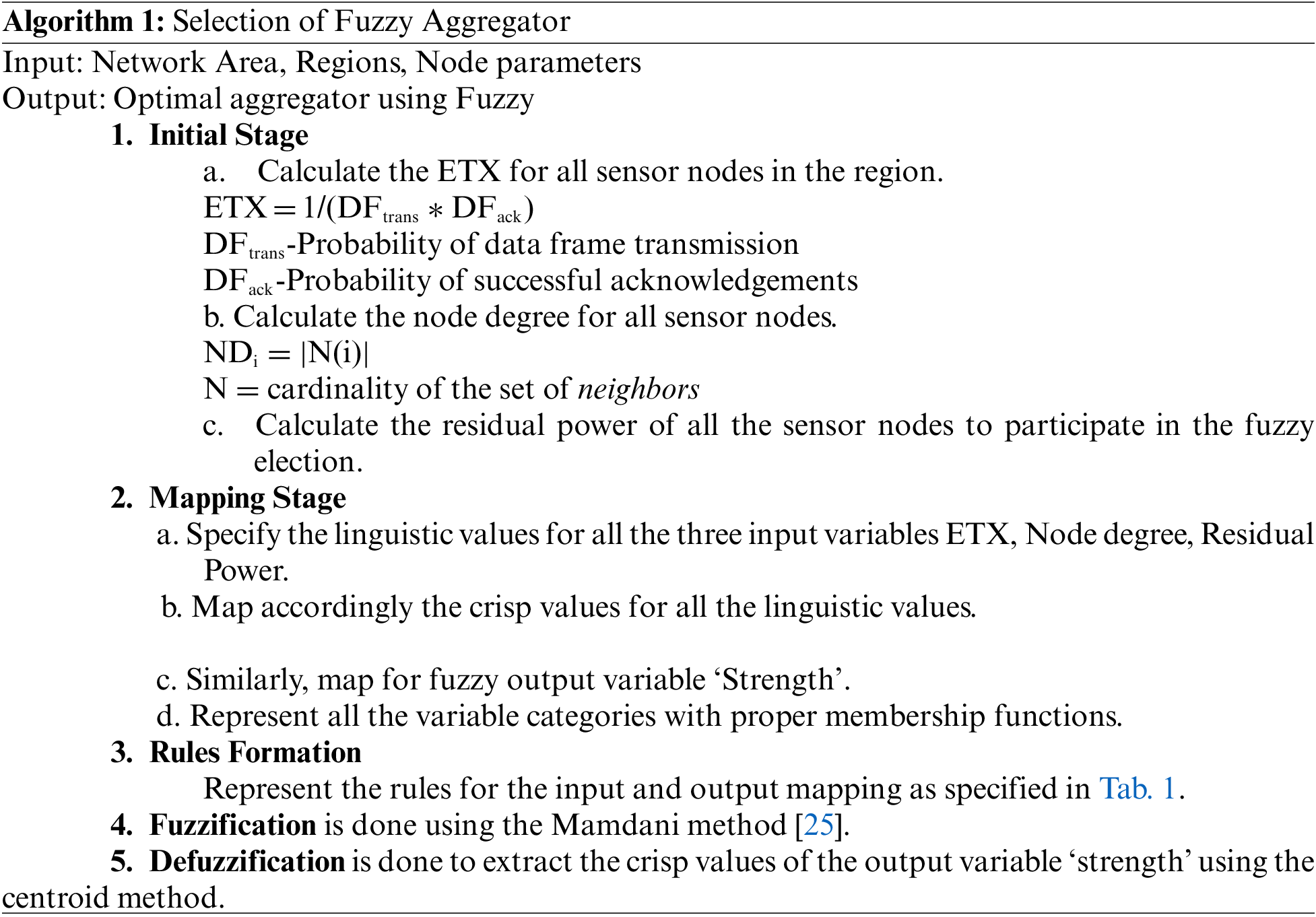
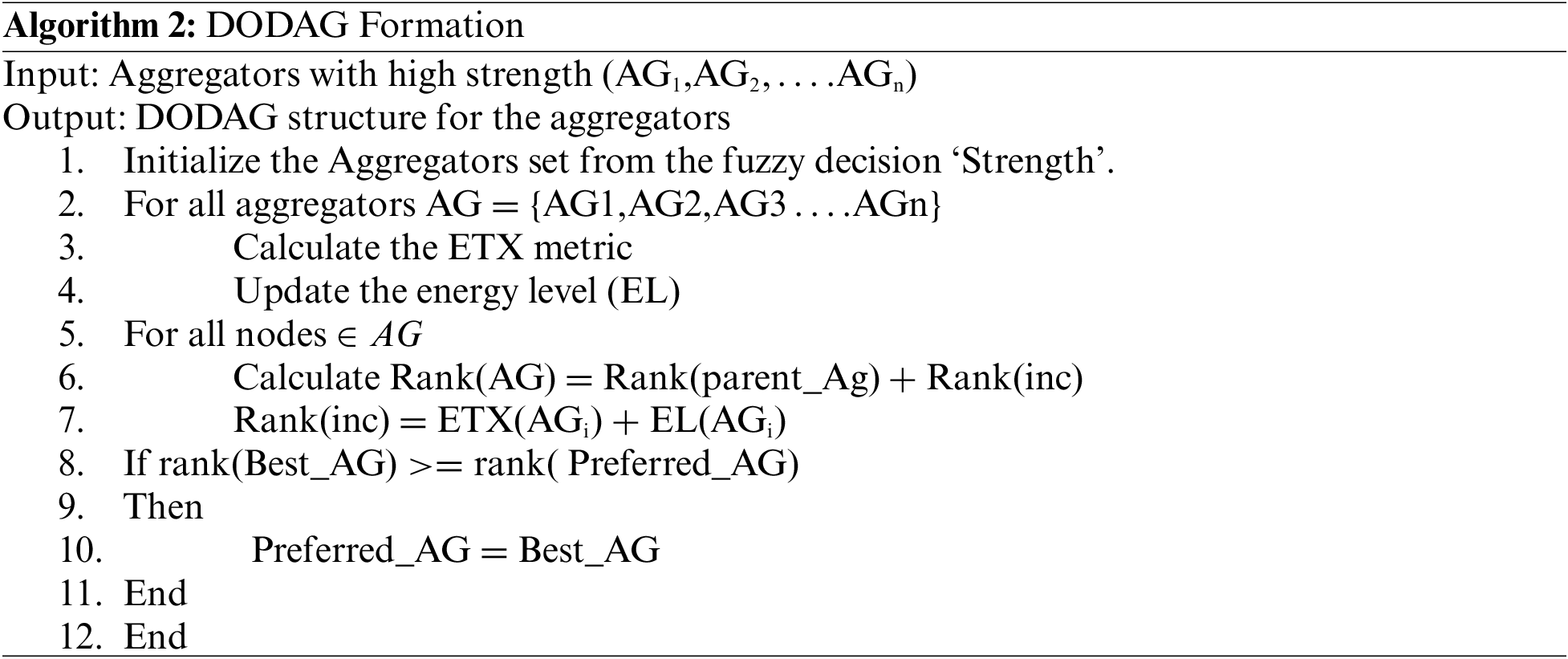

3.4 Fuzzy-Aggregator Specifications
Linguistic variable: Linguistic variable offers a very important role in the application of fuzzy logic. There are three Fuzzy Variables formulated for the aggregator selection, namely the Expected Transmission (ETX), Node Degree, and Residual Power. Linguistic Values-For all the three variables used for aggregator, selection has the following linguistic values.
■ The ETX variable is divided into 3 fuzzy sets, namely: Short, Medium, Long
■ Node Degree variable is divided into 3 fuzzy sets, namely: Min, Average, Max.
■ Residual Power Variable is categorized into 3 fuzzy sets, namely: Less, moderate, high.
Using Fuzzification, crisp (numeric) values are mapped into fuzzy sets and the degree of membership is established. Membership function are graphically used to represent fuzzy set where X-axis represent universe of discourse and y- axis the degree of membership in the interval [0, 1] as appropriate. We in this work have used Triangular function defined by a lower limit a, an upper limit b, and a value m, where a < m < b to build fuzzy membership function which is represented in Eq. (3)
Figs. 3–6 illustrates how crisp values are converted into fuzzy sets. With respect to ETX, for Short, Medium, and Long, linguistic variables are mapped to crisp values in the range 0–30, 20–80, and 70–100, respectively. Eq. (4) shows the membership function for ETX (Medium) linguistic variable as an example. With respect to Node Degree, for Min, Average, Max. linguistic variables are mapped to crisp values in the range 0–20, 15–85 and 80–100, respectively. Eq. (5) shows the membership function for Node Degree (Medium) linguistic variable as an example.
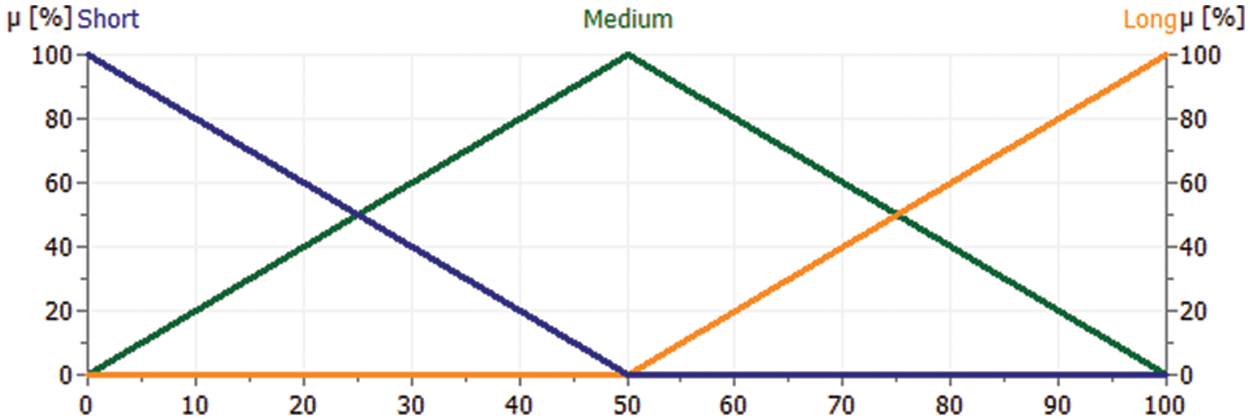
Figure 3: Fuzzy membership functions for ETX

Figure 4: Fuzzy membership functions for node degree

Figure 5: Fuzzy membership functions for residual power

Figure 6: Fuzzy membership functions for strength of aggregator
With respect to Residual Power, for Less, moderate, high, linguistic variables are mapped to crisp values in the range 0–0.5, 0.4–0.6, 0.7–1 respectively. Eq. (6) shows the membership function for Residual Power (Moderate) linguistic variable as an example. Similarly for other linguistic variables, membership functions are mapped.
Defuzzification: During this stage, linguistic values are processed into crisp values. The strength of the aggregator node is categorized into 3 splits namely
a) Not Capable in the range of 0 to 25.
b) Slightly Capable in the range of 26 to 50.
c) Capable in the range of 51 to 75.
d) Highly Capable in the range of 75 to 100. Eq. (7) shows the membership function for strength highly capable linguistic variable as an example.
The membership functions are illustrated in Fig. 3 for ETX and Fig. 4 for Node degree. In Fig. 5, the fuzzy membership functions for the residual power are shown. Similarly, the membership function representation for the output variable which is the strength of the aggregator is represented in Fig. 6.
An algorithmic approach is brought into play in fuzzy control, which involves combining data and rules (conditions), to control the process of selecting the aggregator. In the aggregator selection phase, the variables like ETX, node degree, residual power are considered as input variables and strength as output variables. Historically, rule sets were composed of two sections, the antecedent, and the consequent. The “if” condition of the rule set is the antecedent. The “then” condition is the consequence. The rules mapping is detailed in Tab. 1.
To avoid redundancy, the aggregator node performs data aggregation for the data received from its member nodes. By performing aggregation, the size of data that must be transmitted gets reduced, which in turn reduces the transmission energy required. Balance must be maintained in the aggregation ratio of the received data; else, it leads to the loss of useful information. The proposed FA-ERPL has chosen a fifteen percent aggregation ratio on account of its simplicity. The estimated aggregate data packet size is given by Eq. (8).
where, Lagg(DP) = span of aggregated packet
Lrec(DP) = length of the data packet received from the member sensor nodes
AGGratio = aggregation ratio
Fuzzy Aggregator Energy Efficient RPL (FA-ERPL) is implemented using MATLAB 2021. Sensor nodes are scattered along an area of approximately 100 m * 100 m. Batteries have an initial capacity of 1 J. To ensure the scalability of the protocol, 50, 100, 150, 200, 250 nodes are taken into account for the simulation. Parameters for simulation are shown in Tab. 2.

The performance of FA-ERPL has been evaluated against Energy Efficient RPL without Fuzzy Logic based on metrics which are First Node Die (FND), Half of the Node Die (HND), Total Residual Energy (TRE), and Standard Deviation of Energy Consumption (SD) among the aggregators These are discussed below.
For network lifetime estimation, two important criteria need to be related to node death. They are the first node die (FND) and half node die (HND). For network lifetime estimation, the FND quality factor is more important. The proposed FA-ERPL is compared with E-RPL in terms of network lifetime. To ensure the scalability of the nodes, 50, 100, 150, 200, 250 nodes are taken for simulation. The lifetime of the network is judged by the number of successful rounds covered before FND. From Fig. 7, it is understood that the number of rounds taken for complete communication before the death of the first aggregator is 480 for the 50 nodes setup scenario. Initially, for 50 nodes, FND is near 480 for both protocols. But when the number of nodes increases, the rounds also increase for FA-RPL as compared to E-RPL. The reason for the number of rounds increase for FA-ERPL is that the strength of aggregator selection is based on fuzzy-based rules which take parameters like Energy, Node Degree, and ETX. These fuzzy-based rules decide the strength of the aggregator for selection which is based on different intermediate values rather than two-state logic. So, the number of rounds taken by aggregator selected based on fuzzy based rules for FA-RPL is more for the same number of nodes as compared to E-RPL.
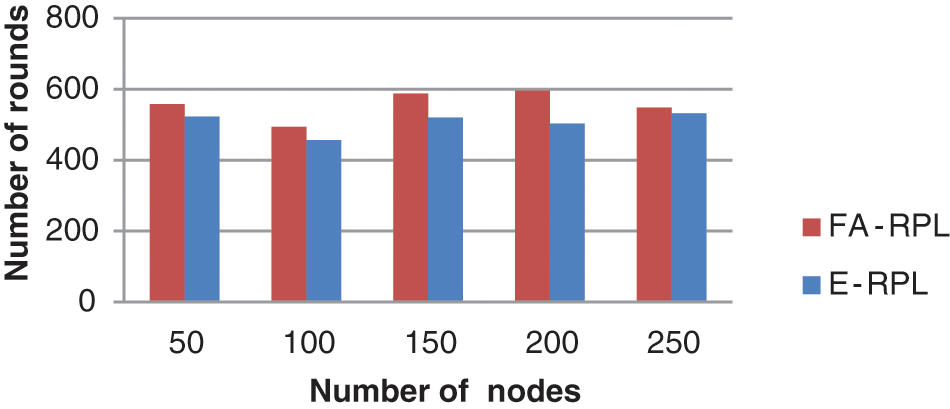
Figure 7: Number of rounds completed before FND
The metric of half of the nodes die (HND) is based on the time interval between the death of the first aggregator node and half of the aggregator nodes die. The time here is represented as the number of successful communication rounds. When compared to the proposed FA-ERPL with E-RPL, the lifetime of the network withstands more in the proposed work. This is because in the proposed FA-RPL the nodes first communicate with the aggregator which is selected using a fuzzy inference system. The role of the aggregator is to reduce the load in the network which in turn increases the number of completed rounds before HND. The reason behind the HND is that if most of the aggregators fail due to overload, then the entire network is not ready to complete the further communication of data packets. Fig. 8 shows that for the 50 nodes setup, the number of rounds completed is 600 in E-RPL and 623 in FA-ERPL. Since the nodes are distributed randomly, for a 100 case scenario the number of rounds completed before HND in E-RPL is 520 and for FA-ERPL is 545. The increase in the number of rounds specifies that the proposed FA-ERPL increases the lifetime of aggregator nodes. The reason being the selection of aggregator is not based on probabilistic percentage values but based on fuzzy inference system. These fuzzy inference rules decide on the aggregator selection based on strength which got a lot of intermediate values between Capable and Not Capable in making a decision for communication and ultimately result in increased rounds of communication before half node Die as compared to E-RPL.
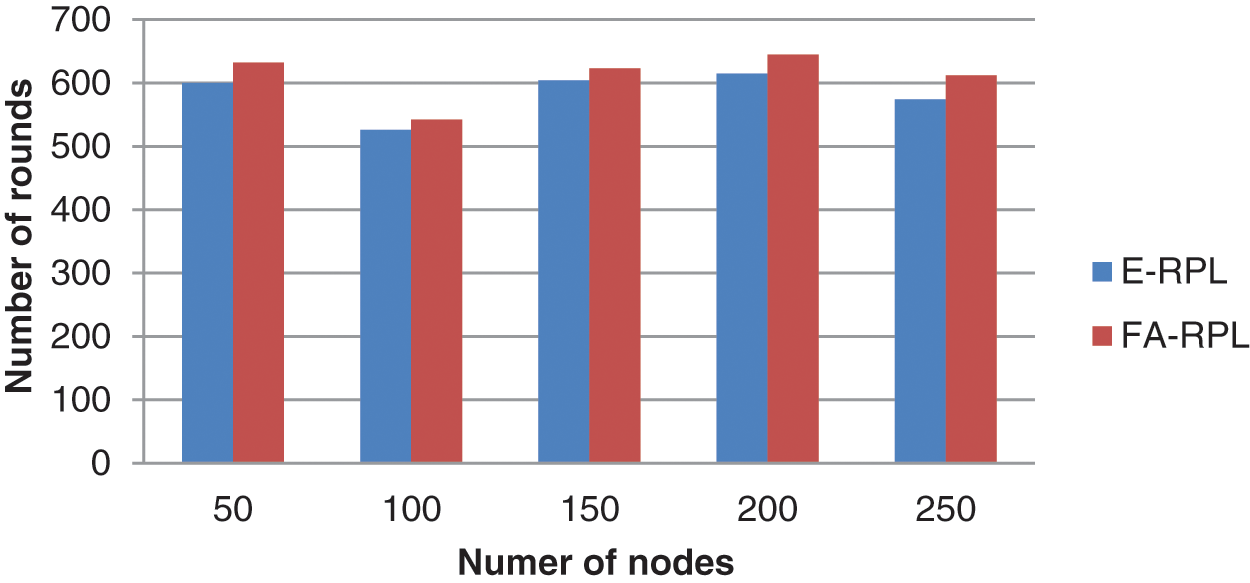
Figure 8: Number of rounds completed before HND
5.3 Average Energy Consumption
The average energy consumption of the entire network is depicted in Fig. 9. To ensure the scalability of the proposed work, 50, 100, 150, 200 and 250 nodes are taken for simulation. For each node, 1 joule energy is taken initially. Approximately, 0.056 joules are consumed by 100 nodes set up for one round in E-RPL whereas it is 0.049 joule in FA-RPL. When taken for 250 nodes setup, it is doubled i.e., 0.20-joule consumption in E-RPL whereas 0.13 joule in FA-ERPL. The reason for reduced energy consumption in FA-ERPL as compared to E-RPL is based on the strength of the aggregator selected for each region where fuzzy inference rules are formed by taking input values like ETX, Energy, and Node degree. These fuzzy-based rules decide the strength of the aggregator for selection which is based on different intermediate values rather than two-state logic. This has resulted in reduced energy consumption in FA-RPL as compared to E-RPL.
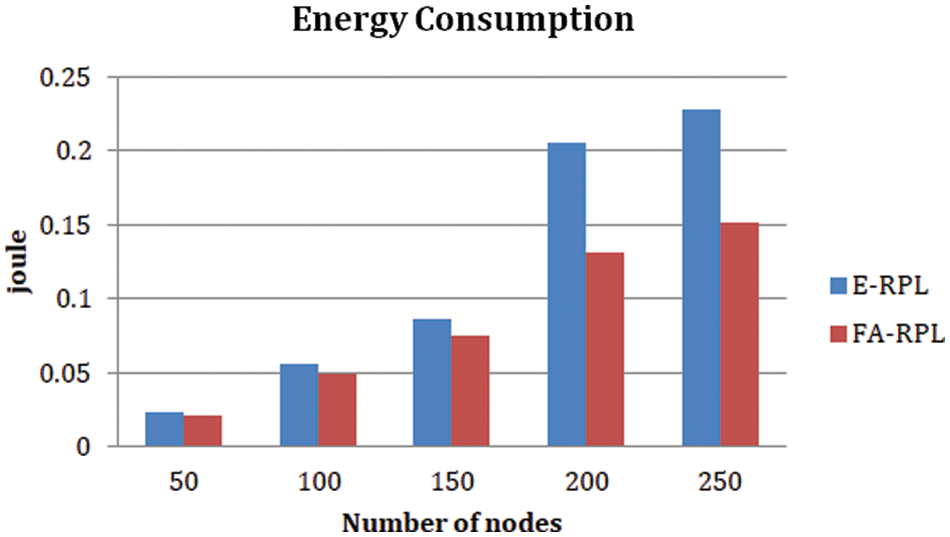
Figure 9: Energy consumption
5.4 Deviation in Energy Consumption by Aggregators
It is also important to evaluate the impact of load distribution on network connectivity. If an aggregator dies due to a heavy workload, it will make the network unreachable. Load distribution is reflected based on the standard deviation of energy consumption. For 250 nodes set up, there are 16 aggregators chosen. These aggregators are selected based on Fuzzy based mechanism. The deviation of energy consumption among all the aggregators is depicted in Fig. 10. It is observed from the deviation that an average of 20% deviation is there in FA-ERPL when compared with the protocol without fuzzy. The energy consumption by each aggregator for the entire communication process is calculated. To ensure the balance in the energy consumption among the aggregators, the deviation of each aggregator’s energy from the total energy consumption is done. It is observed from the energy deviation, FA-ERPL consumes an average of 20% deviation which is less when compared to the non-fuzzy aggregator approach.
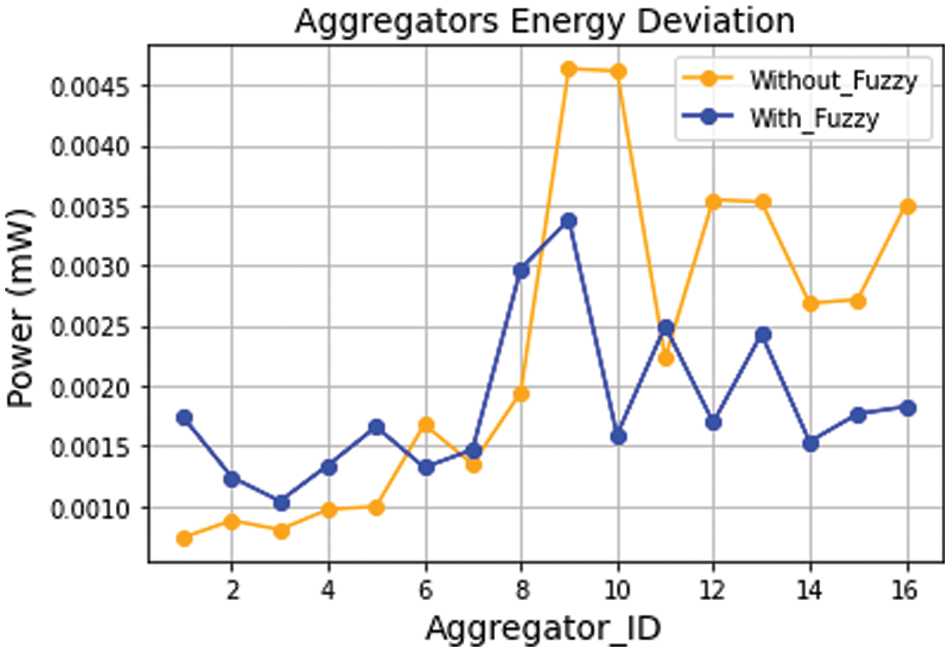
Figure 10: Aggregator’s load deviation
The modern evolution of IoT makes it easier to communicate in the forest region for better sustainability and biological balance. Since smart forests manage their forests using sensor nodes and wireless communication, there is more energy that is required for remote monitoring. Since the nodes are battery-operated, there is potential for energy constraints. There has been work done where Energy Efficient and Aggregation based routing has been developed for IoT-based systems in Forest environments. There were some challenges pertaining to the performance of the routing in terms of scalability, energy consumption. So, we here have proposed FA-ERPL which is Fuzzy based Aggregator Selection in Energy-based RPL routing. The aggregator is selected using a fuzzy inference system for each region which receives data from each node, aggregates it, and then transmits it to the Fog/Edge Node thereby saving energy and improving the scalability. FA-ERPL is compared with E-RPL in terms of FND, HND, energy consumption, and deviation of aggregator’s energy. The use of Fuzzy logic in the aggregator selection process has improved the performance in comparison with E-RPL. The stability period along with FND, HND, and the rate of emergence of new aggregators has been greatly increased. The entire system was validated for increasing number of nodes from 50 to 250 nodes network which shows enhanced performance. This is a clear indication that the same methodology would have even better enhancement with a greater number of nodes say 500 or 1000 node set up. In the future, there is also a need to bring a fuzzy-based approach with optimization for the Fog/Edge node localization for efficient routing. Also, with the advent of mobile IoT applications, there is a need to modify the proposed FA-ERPL for better efficiency. Fuzzy with Neural Model can be incorporated with real time historical data for aggregator selection which can give more better intelligence and performance. Lastly the system can deployed in real time forest environment scenario as test bed for validating the network performance.
Funding Statement: This work is partially funded by FCT/MCTES through national funds and, when applicable, co-funded EU funds under the Project UIDB/50008/2020; Ministry of Science and Higher Education of the Russian Federation, Grant 08-08; and by the Brazilian National Council for Scientific and Technological Development-CNPq, via Grant No. 313036/2020-9.
Conflicts of Interest: The authors declare that they have no conflicts of interest to report regarding the present study.
1. M. Y. Hariyawan, A. Gunawan and E. H. Putra, “Wireless sensor network for forest fire detection,” Telkomnika, vol. 11, no. 3, pp. 563–574, 2013. [Google Scholar]
2. S. Srividhya and S. Sankaranarayanan, “IoT–fog enabled framework for forest fire management system,” in Fourth World Conf. on Smart Trends in Systems, Security and Sustainability (WorldS4), London, UK, pp. 273–276, 2020. [Google Scholar]
3. G. Oguntala, R. Abd-Alhameed, S. Jones, J. Noras, M. Patwary et al., “Indoor location identification technologies for real-time IoT-based applications: An inclusive survey,” Computer Science Review, vol. 1, no. 30, pp. 55–79, 2018. [Google Scholar]
4. S. Sindhu and M. Saravanan, “Architectural framework for multi sensor data fusion and validation in IoT based system,” in IEEE Int. Conf. on Communication Systems and Network Technologies (CSNT), Bhopal, India, pp. 448–452, 2021. [Google Scholar]
5. S. Zhang, W. Wang, S. Tang, S. Jin and T. Jiang, “Robot-assisted backscatter localization for iot applications,” IEEE Transactions on Wireless Communications, vol. 19, no. 9, pp. 5807–18, 2020. [Google Scholar]
6. A. Divya, T. Kavithanjali and P. Dharshini, “IoT enabled forest fire detection and early warning system,” in IEEE Int. Conf. on System, Computation, Automation and Networking (ICSCAN), Pondicherry, India, pp. 1–5, 2019. [Google Scholar]
7. T. Winter, P. Thubert, A. Brandt, J. W. Hui, R. Kelsey et al., “RPL: IPv6 routing protocol for low-power and lossy networks,” Rfc Standards, vol. 6550, pp. 1–57, 2012. [Google Scholar]
8. S. Srividhya and S. Sankaranarayanan, “IoT enabled energy efficient routing in forest fire,” in Proc. of the Int. Conf. on Communications and Cyber-Physical Engineering (ICCCE), Hyderabad, India, pp. 9–10, 2021. [Google Scholar]
9. S. Swaminathan, S. Sankaranarayanan, S. Kozlov and J. J. Rodrigues, “Compression-aware aggregation and energy-aware routing in iot–fog-enabled forest environment,” Sensors, vol. 21, no. 13, pp. 1–18, 2021. [Google Scholar]
10. V. Rajaram and N. Kumaratharan, “An optimized clustering using hybrid meta-heuristic approach for wireless sensor networks,” International Journal of Communication Systems, vol. 33, no. 18, pp. 1–12, 2020. [Google Scholar]
11. V. Rajaram and N. Kumaratharan, “Multi-hop optimized routing algorithm and load balanced fuzzy clustering in wireless sensor networks,” Journal of Ambient Intelligence and Humanized Computing, vol. 12, no. 3, pp. 4281–4289, 2020. [Google Scholar]
12. S. Srividhya, V. Ganapathy and V. Rajaram, “Fuzzy based hierachical unequal clustering in wireless sensor networks,” Indian Journal of Science and Technology, vol. 9, no. 37, pp. 1–7, 2016. [Google Scholar]
13. R. Manchanda and K. Sharma, “Energy efficient compression sensing-based clustering framework for IoT-based heterogeneous WSN,” Telecommunication Systems, vol. 74, no. 3, pp. 311–330, 2020. [Google Scholar]
14. I. Hosni and N. Hamdi, “Cross layer optimization of end to end delay in WSN for smart grid communications,” in Int. Symp. on Signal, Image, Video and Communications (ISIVC), Piscataway, New Jersey, USA, pp. 217–223, 2016. [Google Scholar]
15. M. M. Agarwal, H. Saini, M. C. Govil, “Probabilistic and fuzzy based efficient routing protocol for mobile Ad Hoc networks,” Recent Advances in Computer Science and Communications (Formerly: Recent Patents on Computer Science), vol. 13, no. 3, pp. 422–432, 2020. [Google Scholar]
16. S. Sankar and P. Srinivasan, “Energy and load aware routing protocol for internet of things,” International Journal of Advances in Applied Sciences (IJAAS), vol. 7, no. 3, pp. 255–264, 2018. [Google Scholar]
17. P. Karkazis, H. C. Leligou, L. Sarakis, T. Zahariadis, P. Trakadas et al., “Design of primary and composite routing metrics for RPL-compliant wireless sensor networks,” in Int. Conf. on Telecommunications and Multimedia (TEMU), Heraklion, Greece, pp. 13–18, 2012. [Google Scholar]
18. P. O. Kamgueu, E. Nataf and T. N. Djotio, “On design and deployment of fuzzy-based metric for routing in low-power and lossy networks,” in IEEE 40th Local Computer Networks Conf. Workshops (LCN Workshops), Florida, USA, pp. 789–790, 2015. [Google Scholar]
19. S. Bhandari, S. K. Sharma and X. Wang, “Latency minimization in wireless IoT using prioritized channel access and data aggregation,” in Global Communications Conf., Singapore, pp. 1–6, 2017. [Google Scholar]
20. S. Verma, S. Kaur, D. B. Rawat, C. Xi, L. T. Alex et al., “Intelligent framework using iot-based wsns for wildfire detection,” IEEE Access, vol. 19, no. 9, pp. 48185–48196, 2021. [Google Scholar]
21. B. Shakya, A. Bruce and I. MacGill, “Survey based characterisation of energy services for improved design and operation of standalone microgrids,” Renewable and Sustainable Energy Reviews, vol. 1, no. 101, pp. 493–503, 2019. [Google Scholar]
22. P. S. Mehra, M. N. Doja and B. Alam, “Fuzzy based enhanced cluster head selection (FBECS) for WSN,” Journal of King Saud University-Science, vol. 32, no. 1, pp. 390–401, 2020. [Google Scholar]
23. R. J. Tom, S. Sankaranarayanan, V. H. Albuquerque and J. J. Rodrigues, “Aggregator based RPL for an IoT-fog based power distribution system with 6LoWPAN,”China Communications, vol. 17, no. 1, pp. 104–117, 2020. [Google Scholar]
24. J. Cui and F. Valois, “Data aggregation in wireless sensor networks: Compressing or forecasting,” in IEEE Wireless Communications and Networking Conf. (WCNC), Istanbul, Turkey, pp. 2892–2897, 2014. [Google Scholar]
25. M. Panchal and A. Yadav, “Energy efficient wireless sensor network using fuzzy logic,” in Proc. Int. Conf. on Current Trends in Computer, Electrical, Electronics and Communication (CTCEEC), Mysore, India, pp. 459–462, 2017. [Google Scholar]
 | This work is licensed under a Creative Commons Attribution 4.0 International License, which permits unrestricted use, distribution, and reproduction in any medium, provided the original work is properly cited. |